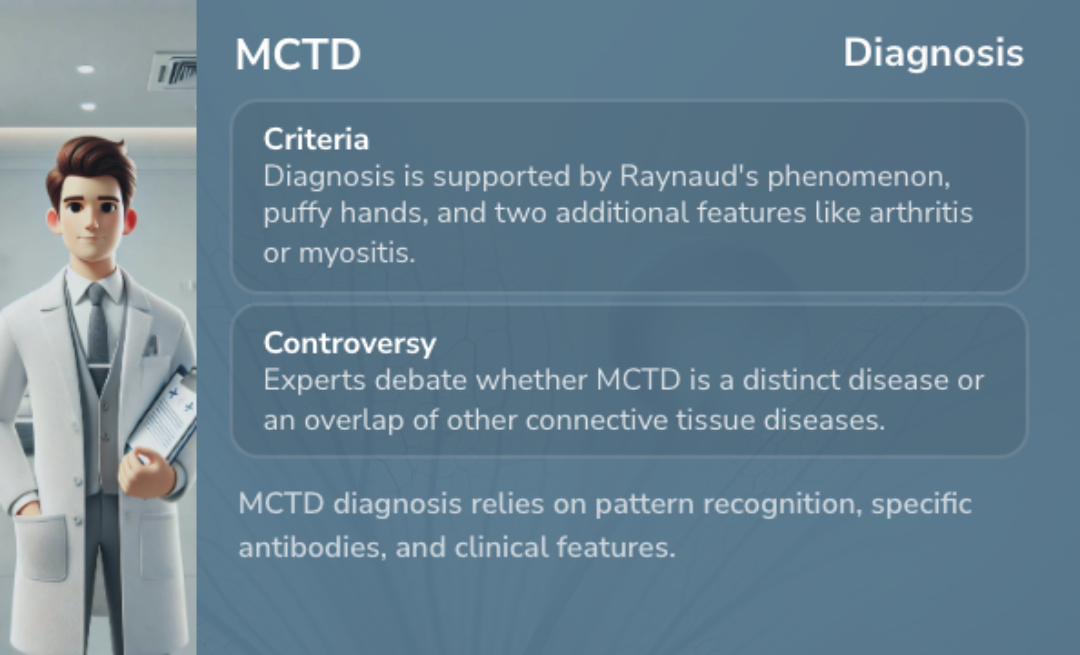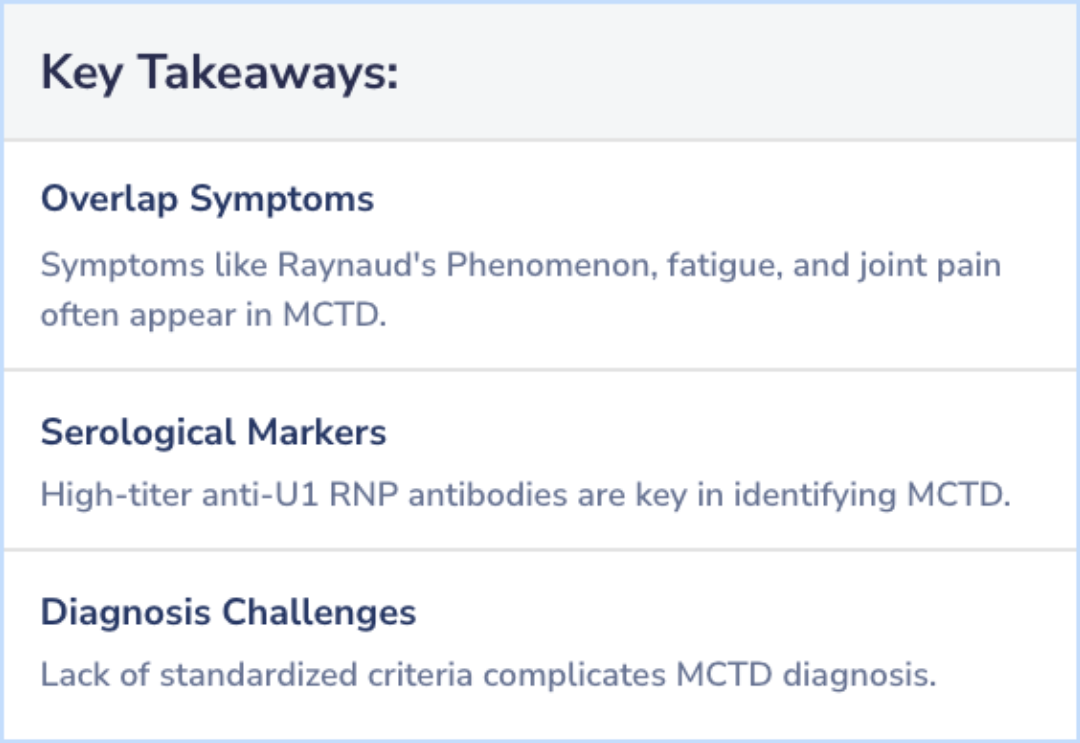MCTD
Evidence Based Answers
Understanding MCTD Diagnosis
Mixed Connective Tissue Disease combines various autoimmune symptoms, with Raynaud's Phenomenon and serological markers like anti-U1 RNP acting as indicators. Diagnosis is complex due to varied criteria and symptom overlap with other diseases.

Raynaud's, anti-U1 RNP markers, and non-standard criteria are key in MCTD diagnosis.
Recognizing Symptoms and Features in MCTD
Mixed Connective Tissue Disease (MCTD) shows symptoms that overlap with various autoimmune conditions. Patients frequently encounter Raynaud's Phenomenon, where fingers and toes change color and hurt when exposed to cold or stress. In addition, fatigue, joint pain, and swollen hands are commonly reported.
These symptoms can be vague and may mimic other connective tissue diseases. However, noticing these overlapping features can aid in building a clearer path for identifying MCTD.
These symptoms can be vague and may mimic other connective tissue diseases. However, noticing these overlapping features can aid in building a clearer path for identifying MCTD.
“
Source Quotes:
Early in the course of disease, patients may have somewhat nonspecific symptoms such as fatigue, myalgias, arthralgias, and Raynaud’s phenomenon.
The most common clinical manifestations of mixed connective disease are Raynaud’s phenomenon, arthralgias, swollen joints, esophageal dysfunction, muscle weakness and fingers sausage-like appearance together with the presence of anti-ribonucleoprotein (RNP) antibodies.
Role of Antibodies in MCTD Diagnosis
Diagnosing MCTD often involves examining specific antibodies, especially high-titer anti-U1 ribonucleoprotein (RNP) antibodies. These antibodies are key markers that suggest the presence of MCTD in patients. Together with clinical symptoms, these markers help set MCTD apart from similar autoimmune conditions.
While these serological markers are useful, the absence of standardized guidelines makes outlining diagnostic criteria challenging. Doctors must consider both serological data and symptom presentation to effectively diagnose MCTD.
While these serological markers are useful, the absence of standardized guidelines makes outlining diagnostic criteria challenging. Doctors must consider both serological data and symptom presentation to effectively diagnose MCTD.
“
Source Quotes:
The diagnosis of MCTD is critically dependent on the demonstration of high-titer anti-U1-RNP antibodies.
To date, there are no uniform guidelines for evaluating patients presenting with systemic disease features and a high titer of serum autoantibodies directed against the U1 ribonucleoprotein (anti-RNP), and there is no international consensus on how, when, and in whom MCTD should be diagnosed.
Diagnosis Challenges in MCTD
Diagnosing MCTD involves combining clinical symptoms with serological evidence, though this process can be challenging. The diagnostic criteria for MCTD vary, contributing to confusion in the approach. This lack of standardization can be a barrier for both patients and healthcare providers seeking a clear diagnosis.
MCTD presents distinct characteristics alongside symptoms common to diseases like systemic lupus erythematosus and rheumatoid arthritis. Physicians need to be skilled in identifying these overlaps for accurate diagnosis and management.
MCTD presents distinct characteristics alongside symptoms common to diseases like systemic lupus erythematosus and rheumatoid arthritis. Physicians need to be skilled in identifying these overlaps for accurate diagnosis and management.
“
Source Quotes:
Although there are no American College of Rheumatology criteria for the classification of MCTD, several criteria for classification have been published.
The four coexisting criteria sets for MCTD further complicate this issue.
Debate Over MCTD Classification
The classification of MCTD is debated, with questions about whether it should be seen as a distinct disease or as an overlap with features from other conditions. Some experts argue it has unique characteristics deserving separate recognition, while others see it as part of broader diseases.
This debate highlights the complexity in diagnosing MCTD, which can show symptoms common to multiple connective tissue diseases. Recognizing these overlaps helps in understanding MCTD and managing its nuances.
This debate highlights the complexity in diagnosing MCTD, which can show symptoms common to multiple connective tissue diseases. Recognizing these overlaps helps in understanding MCTD and managing its nuances.
“
Source Quotes:
However, after years, other studies supported the concept of MCTD as a different disease.
The concept of mixed connective tissue disease (MCTD) as a separate immune-mediated connective tissue disease (CTD) was first introduced by Gordon C. Sharp and coworkers > 40 years ago, but there is still no consensus regarding the disease definitions, the classification criteria, or the relationship with other CTDs.
Key Takeaways
Conclusions
Mixed Connective Tissue Disease (MCTD) presents a diagnostic challenge due to its symptom overlap with other autoimmune diseases. Key symptoms such as Raynaud's Phenomenon, fatigue, and joint pain, accompanied by high-titer anti-U1 RNP antibodies, form the basis for recognizing MCTD.
Despite these indicators, varied diagnostic criteria and the ongoing debate on MCTD as a distinct entity contribute to diagnostic uncertainty. Clinicians navigate these complexities by integrating serological and clinical data to manage patient care effectively.
Despite these indicators, varied diagnostic criteria and the ongoing debate on MCTD as a distinct entity contribute to diagnostic uncertainty. Clinicians navigate these complexities by integrating serological and clinical data to manage patient care effectively.
